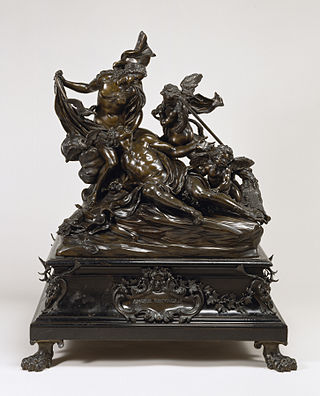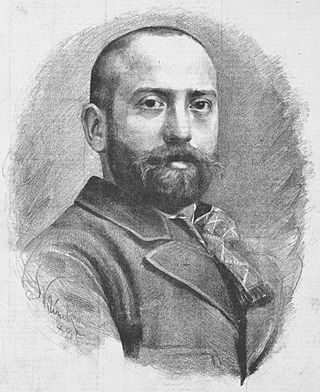Related Research Articles

Art Nouveau is an international style of art, architecture, and applied art, especially the decorative arts. It was often inspired by natural forms such as the sinuous curves of plants and flowers. Other characteristics of Art Nouveau were a sense of dynamism and movement, often given by asymmetry or whiplash lines, and the use of modern materials, particularly iron, glass, ceramics and later concrete, to create unusual forms and larger open spaces. It was popular between 1890 and 1910 during the Belle Époque period, and was a reaction against the academicism, eclecticism and historicism of 19th century architecture and decorative art.

Porcelain is a ceramic material made by heating raw materials, generally including kaolinite, in a kiln to temperatures between 1,200 and 1,400 °C. The greater strength and translucence of porcelain, relative to other types of pottery, arise mainly from vitrification and the formation of the mineral mullite within the body at these high temperatures. End applications include tableware, decorative ware such as figurines, and products in technology and industry such as electrical insulators and laboratory ware.

Émile Gallé was a French artist and designer who worked in glass, and is considered to be one of the major innovators in the French Art Nouveau movement. He was noted for his designs of Art Nouveau glass art and Art Nouveau furniture, and was a founder of the École de Nancy or Nancy School, a movement of design in the city of Nancy, France.

Faience or faïence is the general English language term for fine tin-glazed pottery. The invention of a white pottery glaze suitable for painted decoration, by the addition of an oxide of tin to the slip of a lead glaze, was a major advance in the history of pottery. The invention seems to have been made in Iran or the Middle East before the ninth century. A kiln capable of producing temperatures exceeding 1,000 °C (1,830 °F) was required to achieve this result, the result of millennia of refined pottery-making traditions. The term is now used for a wide variety of pottery from several parts of the world, including many types of European painted wares, often produced as cheaper versions of porcelain styles.

Goldscheider Porcelain Manufactory and Majolica Factory was an Austrian ceramic manufactory.

Liberty style was the Italian variant of Art Nouveau, which flourished between about 1890 and 1914. It was also sometimes known as stile floreale, arte nuova, or stile moderno. It took its name from Arthur Lasenby Liberty and the store he founded in 1874 in London, Liberty Department Store, which specialized in importing ornaments, textiles and art objects from Japan and the Far East. Major Italian designers using the style included Ernesto Basile, Ettore De Maria Bergler, Vittorio Ducrot, Carlo Bugatti, Raimondo D'Aronco, Eugenio Quarti, and Galileo Chini.

Mintons was a major company in Staffordshire pottery, "Europe's leading ceramic factory during the Victorian era", an independent business from 1793 to 1968. It was a leader in ceramic design, working in a number of different ceramic bodies, decorative techniques, and "a glorious pot-pourri of styles - Rococo shapes with Oriental motifs, Classical shapes with Medieval designs and Art Nouveau borders were among the many wonderful concoctions". As well as pottery vessels and sculptures, the firm was a leading manufacturer of tiles and other architectural ceramics, producing work for both the Houses of Parliament and United States Capitol.

Massimiliano Soldani or Massimiliano Soldani Benzi was an Italian baroque sculptor and medallist, mainly active in Florence. Born at Montevarchi, the son of a Tuscan cavalry captain, Soldani was employed by the Medici for his entire career.

The Doccia porcelain manufactory, at Doccia, a frazione of Sesto Fiorentino, near Florence, was in theory founded in 1735 by marchese Carlo Ginori near his villa, though it does not appear to have produced wares for sale until 1746. It has remained the most important Italian porcelain factory ever since.
Jean René Gauguin was a French-Danish sculptor. He won a bronze medal for Denmark in the art competitions at the 1924 Summer Olympics for his Boxer.

Alexandre Bigot was a French ceramicist. He was primarily a ceramics manufacturer, producing the designs of many artists and architects of the French Art Nouveau movement, including: Jules Lavirotte, Hector Guimard, Louis Majorelle, Henri Sauvage, Henry van de Velde, Auguste Perret, Andre Arfvidson, Anatole de Baudot and more.

José Moreno Carbonero was a Spanish painter and decorator. A prominent member of the Málaga School of Painting, he is considered one of the last great history painters of the 19th century. He was a celebrated portrait painter who enjoyed the patronage of Madrid's high society. He also created genre scenes and some landscapes, vedutas and still lifes.

Emaux de Briare is a French company specializing today in mosaics. Whilst the manufactory in Briare originally started with earthenware pottery, the factory founded in Paris by Jean-Félix Bapterosses (1813–1885) initially began manufacturing porcelain buttons in 1845. They merged in 1851, at which date its international development started: 1851 in The Great Exhibition, UK and as early as 1853 in the United States.

George Nicholson, was an English botanist and horticulturist, amongst 60 awarded the Victoria Medal of Honour by the Royal Horticultural Society in 1897 for their contributions to horticulture. He is noted for having edited "The Illustrated Dictionary of Gardening", produced as an eight-part alphabetical series between 1884 and 1888 with a supplement, and published by L. Upcott Gill of London. It was also published in New York in 1889 by The American Agriculturist in 4 Volumes.

Lot Torelli was an Italian sculptor.

Vojtěch Adalbert Hynais was a Czech painter, designer and graphics artist. He designed the curtain of the Prague National Theatre, decorated a number of buildings in Prague and Vienna, and was a founding member of the Vienna Secession. He was made an Officer of the Légion d'honneur in 1924.
Ulisse Cantagalli (1839-1901) was an Italian pottery producer in Florence, Italy. He was born into a family of Italian pottery makers, the Cantagalli name having been associated with ceramics since the 15th century. However, it's unclear whether they were makers or merchants. It's been established, though, that they were well known in Impruneta as “furnacers”, land and property owners, and that the Cantagalli factory was producing ceramics in Florence by the beginning of the 18th century.

Pierre-Adrien Dalpayrat or Adrien Dalpayrat was a French potter who was a significant figure in French art pottery, especially known for his innovative coloured ceramic glazes, mostly on stoneware, but also earthenware and porcelain. After working for several makers of faience, mostly in the south, from 1889 he established his own studio in Bourg-la-Reine, not far from Paris, with his work on sale in various galleries in the capital and other cities.

Valerie "Vally" Wieselthier was an Austrian-American ceramic artist.

Helmut Leherb was an Austrian artist and representative of the Vienna School of Fantastic Realism, which is close to Surrealism. He was born Helmut Leherbauer in Vienna and is also known as Maître Leherb.
References
- ↑ Dizionario degli Artisti Italiani Viventi: pittori, scultori, e Architetti, by Angelo de Gubernatis. Tipe dei Successori Le Monnier, 1889, page 520-523.